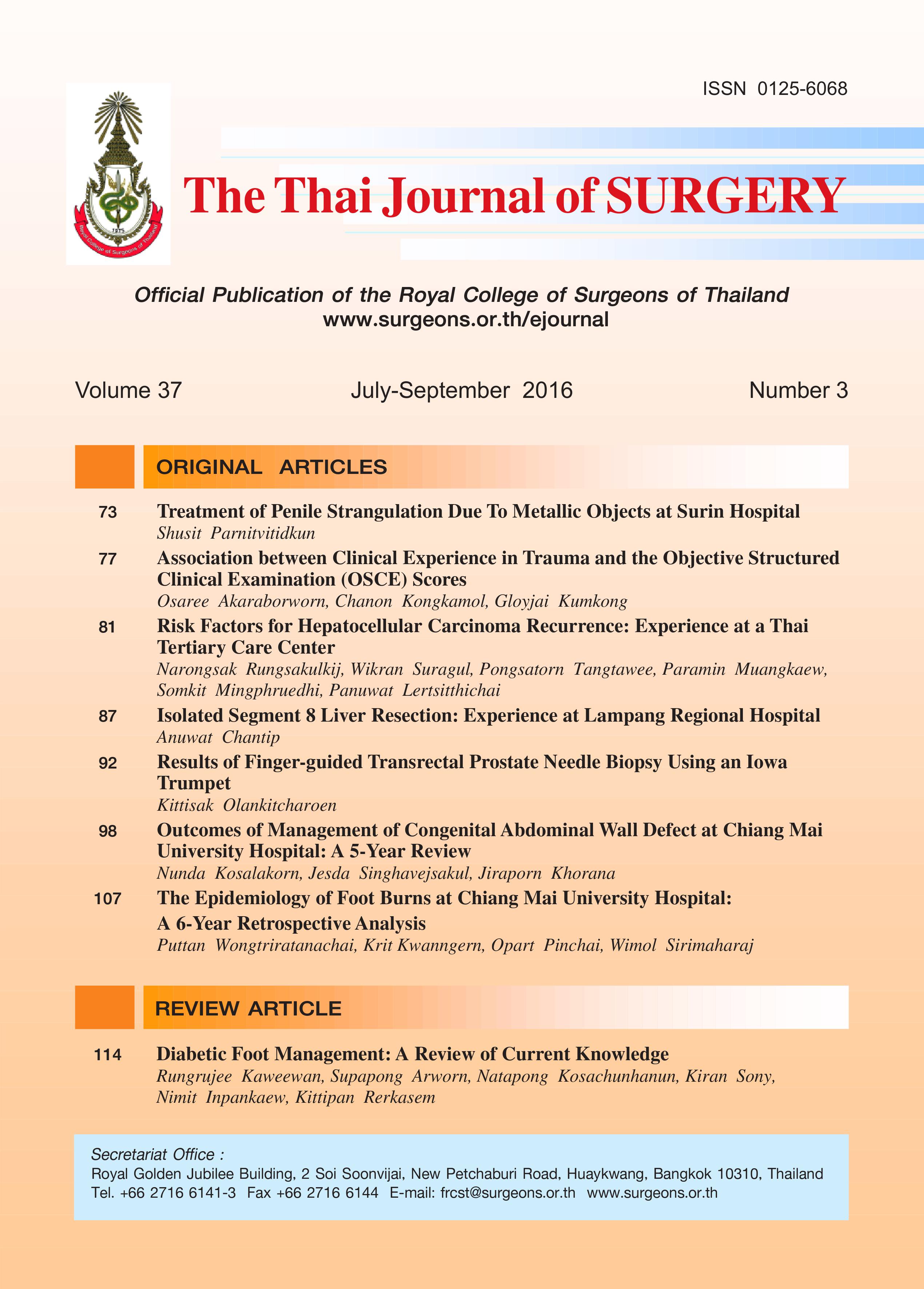Diabetic Foot Management: A Review of Current Knowledge
Keywords:
Diabetes, foot ulcer, update, managementAbstract
In recent years, Diabetes Mellitus (DM) has become more common. This issue will become critical throughout
Asia, including Thailand, because the prevalence increase in type 2 DM shows no sign of reaching a plateau. As is well
known, the most common cause of leg amputation in non-traumatic patients is DM foot. This is because DM patients
have neuropathy, angiopathy, and immunopathy. The aim of the present review is to briefly update information on
DM foot management, in particular on ulcer prevention, foot infection management, off-loading technique,
footwear, revascularization, and prognosis. At the end of this review, we report our research on the strikingly poor
prognosis of Asian DM patients with peripheral arterial disease observed during a six-month period.
References
Diabetes, Diabetic Foot Ulcer, and Lower Extremity
Amputation Among Medicare Beneficiaries, 2006 to 2008:
Data Points #1. Data Points Publication Series. Rockville
(MD): Agency for Healthcare Research and Quality (US);
2011.
2. Yoon KH, Lee JH, Kim JW, et al. Epidemic obesity and type
2 diabetes in Asia. Lancet 2006;368:1681-88.
3. Mehta SK, Breitbart EA, Berberian WS, et al. Bone and wound
healing in the diabetic patient. Foot Ankle Clin 2010;15:411-
37.
4. Garcia-Morales E, Lazaro-Martinez JL, Martinez-Hernandez
D, et al. Impact of diabetic foot related complications on
the Health Related Quality of Life (HRQol) of patients—a
regional study in Spain. Int J Low Extrem Wounds 2011;10:6-
11
5. Rerkasem K, Kosachunhanun N, Tongprasert S, et al. Reducing
lower extremity amputations due to diabetes: the
application of diabetic-foot protocol in Chiang Mai University
Hospital. Int J Low Extrem Wounds 2008;7:88-92.8-21.
6. Walker CM, Bunch FT, Cavros NG, et al. Multidisciplinary
approach to the diagnosis and management of patients
with peripheral arterial disease. Clin Interv Aging 2015;
10:1147-53.
7. Rerkasem K, Kosachunhanun N, Tongprasert S, et al. A
multidisciplinary diabetic foot protocol at Chiang Mai
University Hospital: cost and quality of life. Int J Low Extrem
Wounds 2009;8:153-56.
8. Aragon-Sanchez J. Seminar review: A review of the basis of
surgical treatment of diabetic foot infections. Int J Low
Extrem Wounds 2011;10:33-65.
9. Aragon-Sanchez J. Clinical-pathological characterization
of diabetic foot infections: grading the severity of
osteomyelitis. Int J Low Extrem Wounds 2012;11:107-12.
10. Aragon-Sanchez J. Treatment of diabetic foot osteomyelitis:
A surgical critique. Int J Low Extrem Wounds. 2010;9:37-59,
Malhotra R, Chan CS, Nather A. Osteomyelitis in the diabetic
foot. Diabet Foot Ankle 2014;5.
11. Armstrong DG, Nguyen HC, Lavery LA, et al. Off-loading the
diabetic foot wound: a randomized clinical trial. Diabetes
Care 2001;24:1019-22.
12. Lázaro-Martînez JL, Aragon-Sáanchez J, García-Morales.
Abtibiotic versus conservative surgery for treating diabetic
foot osteomyelitis: a randomized comparative trial. Diabetes
Care 2017;37:789-95.
13. Tone A, Nguyen S, Devemy F, et al. Six-week versus twelveweek
antibiotic therapy for nonsurgically treated diabetic
foot osteomyelitis: a multicenter open-label controlled
randomized study. Diabetes Care 2015;38:302-7
14. Rizzo L, Tedeschi A, Fallani E, et al. Custom-made orthesis
and shoes in a structured follow-up program reduces the
incidence of neuropathic ulcers in high-risk diabetic foot
patients. Int J Low Extrem Wounds 2012;11:59-64.
15. Healy A, Naemi R, Chockalingam N. The effectiveness of
footwear and other removable off-loading devices in the
treatment of diabetic foot ulcers: a systematic review. Curr
Diabetes Rev 2014;10:215-230.
16. Snyder RJ, Kirsner RS, Warriner RA 3rd, Lavery LA, Hanft JR,
Sheehan P. Consensus recommendations on advancing
the standard of care for treating neuropathic foot ulcers in
patients with diabetes. Ostomy Wound Manage 2010;56:S1-
24.
17. Wertsch JJ, Frank LW, Zhu H,et al. Plantar pressures with total
contact casting. J Rehabil Res Dev 1995;32:205-9.
18. Fife CE, Carter MJ, Walker D, et al. Diabetic foot ulcer offloading:
The gap between evidence and practice. Data
from the US Wound Registry. Adv Skin Wound Care 2014;
27:310-6.
19. Bakker K, Apelqvist J, Lipsky BA, et al. The 2015 IWGDF
guidance documents on prevention and management of
foot problems in diabetes: development of an evidencebased
global consensus. Diabetes Metab Res Rev 2015.
20. Adam DJ, Beard JD, Cleveland T, et al. Bypass versus angioplasty
in severe ischaemia of the leg (BASIL): multicentre,
randomised controlled trial. Lancet 2005;366:1925-34.
21. Romiti M, Albers M, Brochado-Neto FC, et al. Meta-analysis
of infrapopliteal angioplasty for chronic critical limb ischemia.
J Vasc Surg 2008;47:975-81.
22. BASIL-2 trial. 2015. Available from: http://www.birmingham.
ac.uk/research/activity/mds/trials/bctu/trials/portfolio-v/
Basil-2/index.aspx [date of access 29 October 2015]
23. BASIL-3. 2015. Available from: http://www.birmingham.ac.
uk/research/activity/mds/trials/bctu/trials/portfolio-v/Basil-
3/index.aspx[date of access 29 October 2015].
24. Armstrong DG, Wrobel J, Robbins JM. Guest Editorial: are
diabetes-related wounds and amputations worse than
cancer? Int Wound J 2007;4:286-7.
25. Aragon-Sanchez J, Hernandez-Herrero MJ, Lazaro-Martinez
JL, et al. In-hospital complications and mortality following
major lower extremity amputations in a series of
predominantly diabetic patients. Int J Low Extrem Wounds
2010;9:16-23.
26. Arwon S, Jumroenketpratheep P, Kosachunhanun N, et al.
Predictive factor to determine the 6 moth risk of major
cardiovascular events after treatment for peripheral artery
disease. the 16th Congress of Asian Society for Vascular
Surgery; 2015 Bangkok.
27. Rerkasem K, Kosachunhanun N, Sony K, et al. Underrecognized
Peripheral Arterial Disease in Patients With
Diabetes Mellitus in Thailand: We Must Consider
Neuroischemic Foot Ulcers From This Fallout. Int J Low Extrem
Wounds 2015;14:132-5.
Downloads
Published
How to Cite
Issue
Section
License
Articles must be contributed solely to The Thai Journal of Surgery and when published become the property of the Royal College of Surgeons of Thailand. The Royal College of Surgeons of Thailand reserves copyright on all published materials and such materials may not be reproduced in any form without the written permission.



